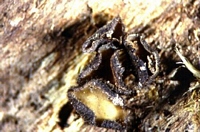|
 Torrendiella madsenii Torrendiella madsenii
SynonymsZoellneria madsenii
BiostatusPresent in region - Indigenous. Non endemic
Images (click to enlarge)
Owner: Peter Johnston | 
Caption: Fig. 10 Torrendiella madsenii (A, PDD 58572; B-H, PDD 58589). A, macroscopic
appearance of apothecia; B, one side of receptacle in vertical section; C, excipulum in vertical
s |
Article: Johnston, P.R.; Gamundí, I.J. (2000). Torrendiella (Ascomycota, Helotiales) on Nothofagus. New Zealand Journal of Botany 38(3): 493-513 (http://www.rsnz.org/publish/abstracts.php).
Description: Apothecia developing on decorticated wood and bark, surface of colonised
wood sometimes blackened; apothecia up to 5 mm diam., stipitate, fleshy, tough; disc plane,
initially pale grey, deep brownish-yellow with age; receptacle pale yellow-brown to almost
black, receptacle covered with numerous, short, fuliginous, somewhat flexuous setae; stipe
tapering toward base, dark, often densely covered with pale, flexuous setae. Paraphyses 2-3
µm diam., more or less undifferentiated to apex, often containing dense yellowish material,
this released as yellow pigment into KOH. Asci 90-130 x 6.5-7.5 µm, narrow-cylindric,
tapering to rounded apex, wall thickened at apex, with elongate, often weakly amyloid pore,
8-spored, with long basal stalk. Ascospores (10-) 12.5-16 (-17) x 3.5-4.5 µm, elliptic-fusoid,
inequilateral, slightly flattened one side, slightly wider in upper half, ends rounded,
sometimes becoming 1-septate, overlapping uniseriate, often producing small, simple
ascoconidia from each end of spore. Ectal excipulum 3-layered; outer layer thin, comprising
long cylindric cells, nongelatinous, some cells hyaline, 2-3 µm diam., commonly with short
divarications, superimposed by network of brown hyphae 4-5 µm diam. with walls encrusted
with dark brown material; central layer comprising tangled, cylindric cells 4-6 µm diam. with
walls hyaline, somewhat thickened, agglutinated; inner layer up to 45 µm thick, comprising
hyphae 3-4 µm diam. with walls thin, finely encrusted, pale brown, non-gelatinous. Setae
arising mostly from dark-walled cells of outer layer of excipulum, but from central layer of
excipulum at margin of disc, (100-) 180-400 x 4-7 µm, tapering gradually to rounded apex
from base, T- or L-shaped at base, walls smooth, brown towards base, becoming paler toward
apex, with uppermost 2-3 cells more or less hyaline, pluriseptate.
APPEARANCE IN CULTURE: OA: 80 mm diam.; aerial mycelium sparse; agar surface variable
in pigmentation with black or whitish patches, or pigmentation may be more or less lacking
completely, or entire colony may be black. PDA: 70 mm diam.; aerial mycelium lacking;
agar surface with irregular patches of dark grey-brown pigment. MEA-M: 80 mm diam.;
aerial mycelium low, tufted, arranged in narrow concentric bands, mostly dark grey but with
scattered patches with brighter orange-brown colours; in reverse dark grey-brown to grey-purplish. MEA-D: 70 mm diam., aerial mycelium sparse, dark; agar uniformly pigmented
dark grey-brown.
Notes: T. madsenii is characterised by large apothecia with a broad stipe, narrow, often
flexuous setae that commonly have a T-shaped base, and ascospores that often produce
ascoconidia. In addition, this is the only Nothofagus-inhabiting species that grows on wood
rather than leaves. Previously reported only from Australia (Spooner 1987), the geographical
range of this species is widened to New Zealand and southern South America. The stromatic
development on the host surface noted by Spooner (1987) for the Australian collections was
not present on the collections from New Zealand. Note that the Argentinian collection Singer
M3005 was recorded erroneously by Gamundí (1962) as Zoellneria eucalypti.
All collections of this species from New Zealand and South America have been on
wood of Nothofagus. Although the host preference of the Australian collections remains
uncertain, all the collecting sites reported by Beaton & Weste (1977) and Spooner (1987)
have Nothofagus present in patches (T. May, Melbourne Botanic Gardens, pers. comm.), as
do those of the additional more recent collections examined from MEL. Torrendiella
collections in MEL from wood from sites where Nothofagus is lacking all represent T.
clelandii or the T. clelandii-like fungus discussed by Spooner (1987). T. clelandii and T. cf.
clelandii may be restricted to Eucalyptus. Apart from the difference in preferred substrate,
they can be distinguished from T. madsenii by their larger asci and ascospores, and by having
setae unbranched at the base.
Most collections of T. madsenii have been made during summer months, unusual for
Torrendiella in the Southern Hemisphere.
|